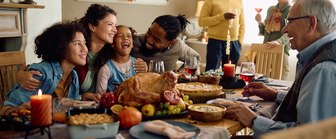A new YouGov survey asked Americans about their siblings: whether they have any and how their place in their family’s birth order relates to their personalities, attachment styles, and relationships with others. The survey found that only children and eldest siblings have much in common when it comes to their personalities and how their role in the family structure shaped them.
Most Americans (88%) had siblings growing up, while 12% were only children. Among only children, 21% said they loved being an only child and 18% liked it; 16% disliked it and 7% hated it.
What about people with siblings? Among oldest siblings, 16% loved being the oldest and 28% liked it. Middle children are less likely to say they loved (12%) or liked (18%) their place in the birth order; 21% of youngest siblings loved being the youngest and 22% liked it. All three groups who grew up with siblings are less likely to say they disliked or hated their situation than only children are.
Many Americans who grew up with siblings had the number they wished to have, but most only children wished they had siblings. Among people who have one sibling, 40% say their desired number of siblings is one, though 28% would prefer to have had two and 18% would have preferred to be an only child. Among people with two siblings, 55% say their desired number of siblings is two. Among people with three siblings, 59% say their desired number of siblings is three.
Among only children, 34% prefer the situation they had, but two-thirds wished for one or more siblings.
Many people feel that their placement in their family’s birth order affected their personality. People who are only children (44%) or the oldest sibling (42%) are more likely than middle children (25%) and youngest children (30%) to feel this way.
Middle children are most likely to say that being middle children had little effect on their personality: 19% say their place in their family’s birth order did not affect their personality very much and 8% say it didn’t affect it at all.
And how would only, oldest, middle and youngest siblings describe their childhood personalities? Within each group, the adjective most commonly chosen from a list of options is sensitive. Around half of only children (52%), oldest siblings (54%), and youngest siblings (52%) say they were sensitive children, as do 44% of middle children.
Beyond sensitivity, there are some differences. Oldest children (26%) and only children (25%) are more likely than youngest siblings (19%) or middle siblings (15%) to say they were perfectionists. Similarly, only children (25%) and oldest siblings (24%) are more likely than youngest (18%) or middle (12%) children to describe their past selves as overachievers.
Youngest children (34%) are more likely than middle (30%), oldest (29%), and only children (26%) to say that they were completely or extroverted as children. Majorities in all groups are more likely to describe themselves as introverted as children.
Birth order may also affect how a person relates to their parents and eventually forms attachments as an adult. The survey shows that the two are connected, without indicating whether either caused the other.
Oldest siblings (34%) are more likely than middle children (30%) and youngest children (24%) to say their primary caregiver’s parenting style was strict, meaning that as children, they were expected to follow rules without questioning them and were punished if they disobeyed.
Youngest siblings (47%) and only children (48%) are particularly likely to see their caregiver’s parenting style as balanced, meaning their caregiver was caring, listened to them, and set clear rules. Oldest (43%) and middle (41%) siblings are slightly less likely to have experienced their caregivers' parenting this way.
Youngest siblings (46%) are the most likely to say they were very close with their parents as children. Around one-third of oldest (34%) and middle (35%) siblings say they were very close with their parents as children, as do 39% of only children.
When it comes to attachment styles, youngest siblings are the most likely to describe themselves as having a secure attachment style (37%), meaning they are comfortable with emotional closeness, are able to trust and rely on others, and effectively communicate needs in relationships. About one-third of middle (33%) and oldest (32%) siblings say this is their attachment style, along with 27% of only children.
Only children are particularly likely to say they have a disorganized attachment style (25%), meaning they experience mixed feelings about closeness, find it difficult to trust others, and may have inconsistent patterns of seeking and avoiding intimacy.
When it comes to the impact of birth order, eldest siblings (51%) are more likely than middle (36%) or youngest (42%) siblings to say it had a positive effect on them. Among only children, 40% think being an only child had a positive impact on them and 18% think it had a negative impact.
Are only children better or worse off than people with siblings? Among only children, 22% think only children are much or somewhat better off than people with siblings and 20% think they’re worse off. Among people with siblings, 13% think only children are better off and 43% think they are worse off.
— Taylor Orth and Carl Bialik contributed to this article
Related:
- How much pressure do Americans deciding on children get from their parents wanting grandchildren?
- What do Americans think about different parenting styles, and which style did they grow up with?
- For Americans with siblings, rivalries often are present in childhood but many fade in adulthood
- One-third of Americans with siblings say their mother has a favorite child
See the results for this YouGov poll
Methodology: The poll was conducted among 2,000 U.S. adult citizens on two separate surveys from October 6 - 10, 2023 and October 23 - 27, 2023, with each survey taken by 1,000 U.S. adult citizens. Respondents were selected from YouGov’s opt-in panel using sample matching. A random sample (stratified by gender, age, race, education, geographic region, and voter registration) was selected from the 2019 American Community Survey. The sample was weighted according to gender, age, race, education, 2020 election turnout and presidential vote, baseline party identification, and current voter registration status. Demographic weighting targets come from the 2019 American Community Survey. Baseline party identification is the respondent’s most recent answer given prior to November 1, 2022, and is weighted to the estimated distribution at that time (33% Democratic, 31% Republican). The margin of error for the overall sample is approximately 3%.
Image: Adobe Stock (Shopping King Louie)














